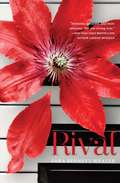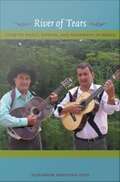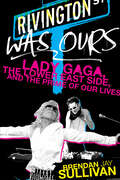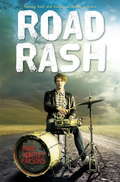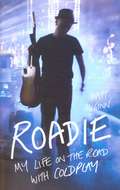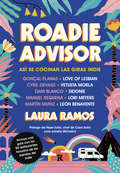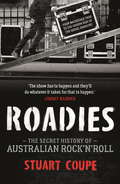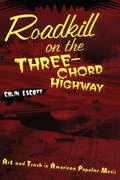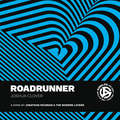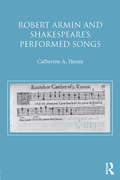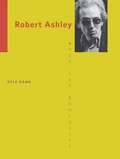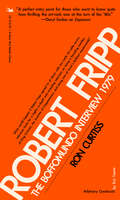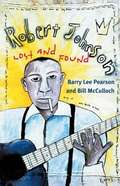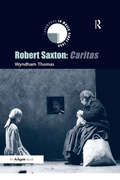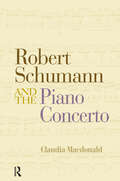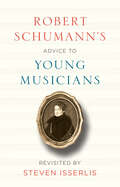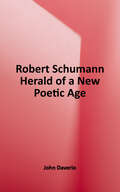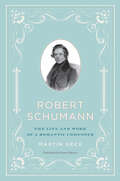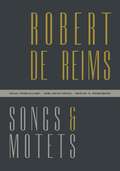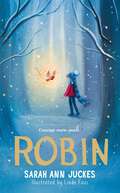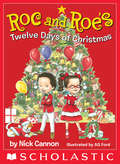- Table View
- List View
Rival
by Sara Bennett WealerBrooke I don't like Kathryn Pease. I could pretend everything's fine between us. I could be nice to her face, then trash her behind her back. But I think it's better to be honest. I don't like Kathryn, and I'm not afraid to admit it. Kathryn I saw a commercial where singers used their voices to shatter glass, but the whole thing is pretty much a myth. The human voice isn't that strong. Human hatred is. Anybody who doubts that should feel the hate waves coming off of Brooke Dempsey. But I don't shatter; I'm not made of glass. Anyway, the parts that break aren't on the outside. Brooke and Kathryn used to be best friends . . . until the night when Brooke ruthlessly turned on Kathryn in front of everyone. Suddenly Kathryn was an outcast and Brooke was Queen B. Now, as they prepare to face off one last time, each girl must come to terms with the fact that the person she hates most might just be the best friend she ever had.
River of Tears: Country Music, Memory, and Modernity in Brazil
by Alexander Sebastian DentRiver of Tears is the first ethnography of Brazilian country music, one of the most popular genres in Brazil yet least-known outside it. Beginning in the mid-1980s, commercial musical duos practicing msica sertaneja reached beyond their home in Brazil's central-southern region to become national bestsellers. Rodeo events revolving around country music came to rival soccer matches in attendance. A revival of folkloric rural music called msica caipira, heralded as msica sertaneja's ancestor, also took shape. And all the while, large numbers of Brazilians in the central-south were moving to cities, using music to support the claim that their Brazil was first and foremost a rural nation. Since 1998, Alexander Sebastian Dent has analyzed rural music in the state of So Paulo, interviewing and spending time with listeners, musicians, songwriters, journalists, record-company owners, and radio hosts. Dent not only describes the production and reception of this music, he also explains why the genre experienced such tremendous growth as Brazil transitioned from an era of dictatorship to a period of intense neoliberal reform. Dent argues that rural genres reflect a widespread anxiety that change has been too radical and has come too fast. In defining their music as rural, Brazil's country musicians--whose work circulates largely in cities--are criticizing an increasingly inescapable urban life characterized by suppressed emotions and an inattentiveness to the past. Their performances evoke a river of tears flowing through a landscape of loss--of love, of life in the countryside, and of man's connections to the natural world.
Rivington Was Ours: Lady Gaga, the Lower East Side, and the Prime of Our Lives
by Brendan Jay Sullivan“Equal parts insightful, funny, romantic and poetic, this is a book that’s not just about Gaga but about the magic of the city.” —Captain” Kirk Douglas, guitarist for The RootsBrendan Jay Sullivan was an up-and-coming DJ in New York City when he met Stefani Germanotta, then a struggling artist, in 2006. She was a go-go dancer who sewed her own outfits but had bigger ambitions—she wanted nothing less than to take over the music world.In this intimate portrait of the budding star, the author describes afternoons sitting with Gaga on the floor of her bare Lower East Side apartment, drinking wine from pint glasses and plotting out the pop stardom that awaited her.Filled with stories of love and heartbreak among Gaga and Sullivan and their circle of aspiring musicians and performers, and set against the vibrant backdrop of the downtown bars and parties of the mid-aughts, Rivington Was Ours is both a love letter to New York and a glimpse behind the veil of one of the biggest musical icons of her generation.“Entertaining . . . An intimate portrait of a specific time—before stardom struck—and a particular place. Fans of Gaga and the downtown New York music scene will find this fascinating.” —Booklist “A fascinating and vivid insight into the cauldron that formed a great musician.” —Andy Rourke, bass guitarist for The Smiths“Brendan Jay Sullivan is a writer’s writer. Yes, he’s that good.” —Gary Shteyngart, New York Times–beststelling author of Super Sad True Love Story“A touching memoir.” —New York Post
Road Rash
by Mark Huntley ParsonsA teenage drummer finds out what life is really like on tour with a rock band in this funny, funky, bittersweet debut YA novel. For anyone who loved Almost Famous or This Is Spinal Tap.After being dropped from one band, 17-year-old drummer Zach gets a chance to go on tour with a much better band. It feels like sweet redemption, but this is one rocky road trip. . . . Zach's in control on the drums, driving the band, keeping things moving at the right pace. But when the show is over, his timing is all off. The jealousies and rivalries within his new group keep him off-balance. The awesome original song he recorded backfires. And the girl he left back home is suddenly talking about this other guy . . . Mark Parsons has written a fast-paced, feel-good novel about a boy finding his place in the world, in a band, and in the music. Zach is a character teens will stand up and cheer for as he lands the perfect gig, and the perfect girl. From the Hardcover edition.
Roadie: My Life on the Road with Coldplay
by Matt McGinnAs Coldplay moves from club gigs to arenas and stadiums worldwide, Matt goes with them; faking it as a band member on U.S. talk shows, flirting with Kylie, saving a life on a French motorway, and even pitching in with the odd guitar riff in the studio. Tales of hurricanes and heat waves, helicopter chases and private jets, plectrum hunters and projectiles all come together.
Roadieadvisor: Así se cocinan las giras indie
by Laura RamosLove of Lesbian, Vetusta Morla, Sidonie, Lori Meyers y León Benavente. Las cinco bandas indie más populares de España revelan los secretos de sus giras de la mano de sus Tour Managers Love of Lesbian, Vetusta Morla, Sidonie, Lori Meyers y León Benavente. Cinco iconos del indie español son los protagonistas de este libro gracias a las confidencias de sus Tours Managers, los encargados de organizar sus giras. Son la cara oculta de unas bandas que mueven masas aquí y al otro lado del Atlántico, pero desde la sombra lo controlan y lo saben todo: sus rituales antes de un concierto, lo que no puede faltar en el camerino, miedos a volar y manías en la carretera, y lo más importante: dónde y cómo comer. Recorremos con ellos un mapa de carreteras del indie nacional que hará las veces de guía gastronómica y de retrato confidencial de algunos de los artistas más destacados del panorama español.
Roadies: The Secret History of Australian Rock'n'Roll
by Stuart CoupeThis is your backstage pass to the hidden side of the music industry - the tantrums, the fights, the tensions, the indulgence, the sex, the alcohol, the drugs. The roadies see it all, and now they are sharing their secrets. Roadies are the unsung heroes of the Australian music industry. They unload the PAs and equipment, they set it all up, they make sure everything is running smoothly before, during and after the gigs. Then they pack everything up in the middle of the night, put it in the back of the truck and hit the road to another town - to do it all over again. They know everything about the pre- and post-show excesses. They bear witness to overdoses, the groupies, the obsessive fans. They are part of - and often organise - all the craziness that goes on behind the scenes of the concerts and pub gigs you go to. From The Rolling Stones to AC/DC, Bob Marley to Courtney Love, Sherbet to The Ted Mulry Gang, INXS to Blondie - these guys have seen it all. And now they're stepping onto the stage and talking.The Roadies' Creed: If it's wet, drink it. If it's dry, smoke it. If it moves, **** it. If it doesn't move, throw it in the back of the truck.'Fabulous . . . a bold portrait' SYDNEY MORNING HERALD on Stuart Coupe's GUDINSKI
Roadkill on the Three-Chord Highway: Art and Trash in American Popular Music
by Colin EscottIt's the real stories, not the publicists' confections, that concern Colin Escott. We hear Perry Como's story in his own words: it wasn't all smooth. We learn about the astonishing twists and turns in Roy Orbison's life, and the stories behind the songs we know so well. And we go down with Vernon Oxford, the last great honky tonk singer, who came to Nashville just a little too late. These are stories for anyone who loves what Escott calls "little songs from great sorrows." They will fascinate even the most casual fan of popular music, and they're told here in sympathetic, engaging, and illuminating prose.
Roadrunner (Singles)
by Joshua CloverJonathan Richman and the Modern Lovers' 1972 song “Roadrunner” captures the freedom and wonder of cruising down the highway late at night with the radio on. Although the song circles Boston's beltway, its significance reaches far beyond Richman's deceptively simple declarations of love for modern moonlight, the made world, and rock & roll. In Roadrunner, cultural theorist and poet Joshua Clover charts both the song's emotional power and its elaborate history, tracing its place in popular music from Chuck Berry to M.I.A. He also locates “Roadrunner” at the intersection of car culture, industrialization, consumption, mobility, and politics. Like the song itself, Clover tells a story about a particular time and place—the American era that rock & roll signifies—that becomes a story about love and the modern world.
Robert Armin and Shakespeare's Performed Songs
by Catherine A. HenzeAfter Robert Armin joined the Chamberlain's Men, singing in Shakespeare's dramas catapulted from 1.25 songs and 9.95 lines of singing per play to 3.44 songs and 29.75 lines of singing, a virtually unnoticed phenomenon. In addition, many of the songs became seemingly improvisatory—similar to Armin's personal style as an author and solo comedian. In order to study Armin's collaborative impact, this interdisciplinary book investigates the songs that have Renaissance music that could have been heard on Shakespeare's stage. They occur in some of Shakespeare's most famous plays, including Much Ado About Nothing, Twelfth Night, Hamlet, and The Tempest. In fact, Shakespeare's plays, as we have them, are not complete. They are missing the music that could have accompanied the plays’ songs. Significantly, Renaissance vocal music, far beyond just providing entertainment, was believed to alter the bodies and souls of both performers and auditors to agree with its characteristics, directly inciting passions from love to melancholy. By collaborating with early modern music editor and performing artist Lawrence Lipnik, Catherine Henze is able to provide new performance editions of seventeen songs, including spoken interruptions and cuts and rearrangement of the music to accommodate the dramatist's words. Next, Henze analyzes the complete songs, words and music, according to Renaissance literary and music primary sources, and applies the new information to interpretations of characters and scenes, frequently challenging commonly held literary assessments. The book is organized according to Armin's involvement with the plays, before, during, and after the comic actor joined Shakespeare's company. It offers readers the tools to interpret not only these songs, but also vocal music in dramas by other Renaissance playwrights. Moreover, Robert Armin and Shakespeare's Performed Songs, written with non-specialized terminology, provides a gateway to new areas of research and interpretation in an increasingly significant interdisciplinary field for all interested in Shakespeare and early modern drama.
Robert Ashley
by Kyle GannThis book explores the life and works of the pioneering opera composer Robert Ashley, one of the leading American composers of the post-Cage generation. Ashley's innovations began in the 1960s when he, along with Alvin Lucier, Gordon Mumma, and David Behrman, formed the Sonic Arts Union, a group that turned conceptualism toward electronics. He was also instrumental in the influential ONCE Group, a theatrical ensemble that toured extensively in the 1960s.During his tenure as its director, the ONCE Festival in Ann Arbor presented most of the decade's pioneers of the performing arts. Particularly known for his development of television operas beginning with Perfect Lives, Ashley spun a long series of similar text/music works, sometimes termed "performance novels." These massive pieces have been compared with Wagner's Ring Cycle for the vastness of their vision, though the materials are completely different, often incorporating noise backgrounds, vernacular music, and highly structured, even serialized, musical structures. Drawing on extensive research into Ashley's early years in Ann Arbor and interviews with Ashley and his collaborators, Kyle Gann chronicles the life and work of this musical innovator and provides an overview of the avant-garde milieu of the 1960s and 1970s to which he was so central. Gann examines all nine of Ashley's major operas to date in detail, along with many minor works, revealing the fanatical structures that underlie Ashley's music as well as private references hidden in his opera librettos.
Robert Fripp: The Boffomundo Interview
by Ron CurtiessOfficially transcribed from the original Boffomundo archives, Robert Fripp: The Boffomundo Interview 1979 reveals an intriguing and unique look into the mind of one of music's masters of precision and creativity -- all through the subtle brilliance of Wayne's World-esque early L. A. cable access hosts Ron Curtiss and Aaron Weiner. Featuring aired and unaired content from their 1979 interview, a new introduction by Ron Curtiss, and additional contextualizing articles and interviews, this is a gem that could have been long forgotten if not for Curtiss’s archival masterminding and his dedication to preserving the prog legacy. This book is a must-have for all fans of King Crimson, David Bowie, philosophical self-inquisition, and technological wizardry. A Rare Bird Exclusive: Purchasers of the ebook will receive access to a video of the full interview.
Robert Johnson: Lost and Found
by Barry Lee Pearson Bill MccullochWith just forty-one recordings to his credit, Robert Johnson (1911-38) is a giant in the history of blues music. Johnson's vast influence on twentieth-century American music, combined with his mysterious death at the age of twenty-seven, has allowed speculation and myths to obscure the facts of his life. The most famous of these legends depicts a young Johnson meeting the Devil at a dusty Mississippi crossroads at midnight and selling his soul in exchange for prodigious guitar skills. In this volume, Barry Lee Pearson and Bill McCulloch examine the full range of writings about Johnson and sift fact from fiction. They compare conflicting accounts of Johnson's life, weighing them against interviews with blues musicians and others who knew the man. Through their extensive research Pearson and McCulloch uncover a life every bit as compelling as the fabrications and exaggerations that have sprung up around it. In examining Johnson's life and music, and the ways in which both have been reinvented and interpreted by other artists, critics, and fans, Robert Johnson: Lost and Found charts the broader cultural forces that have mediated the expression of African American artistic traditions.
Robert Plant: A Life
by Paul ReesThis biography of the solo artist and legendary lead singer of Led Zeppelin “informs and entertains . . . leav[ing] few stones in Plant’s life unturned.” —Mojo magazineRobert Plant by Paul Rees is the definitive biography of Led Zeppelin's legendary frontman. As lead singer for one of the biggest and most influential rock bands of all time—whose song “Stairway to Heaven” has been played more times on American radio than any other track—Robert Plant defined what it means to be a rock god.Over the course of his twenty-year career, British music journalist and editor Paul Rees has interviewed such greats as Sir Paul McCartney, Bruce Springsteen, Madonna, Bono, and AC/DC. Rees now offers a full portrait of Robert Plant for the first time, exploring the forces that shaped him, the ravaging highs and lows of the Zeppelin years—including his relationship with Jimmy Page and John Bonham—and his life as a solo artist today.Illustrated with more than two dozen photographs, Robert Plant: A LIfe is the never-before-told story of a gifted, complicated music icon who changed the face of rock 'n' roll.“Anyone seeking insight into Robert Plant as a man and musician will find it here.” —Q Magazine“Particularly enlightening on Plant’s formative pre-Zep years in the Midlands, A Life puts the singer’s eclectic career into clear context.” —Dave Lewis, Tight But Loose magazine
Robert Saxton: Caritas (Landmarks in Music Since 1950)
by Wyndham ThomasCaritas relates the 'true', yet largely undocumented story of Christine Carpenter, a 14th-century anchoress who moves towards insanity as her desire for a divine revelation continues to be unfulfilled after a period of three years locked in her cell. Although physically isolated, she is aware of the worldly life and love that she has abandoned. The very essence of the drama is the dogmatic refusal of her Bishop to release her from her vows. Set against the backcloth of the Peasants' Uprising (1381), the libretto/play juxtaposes sacred and secular worlds, the relative power and servitude of rulers and serfs, and the terrifying ordeal of Christine who is caught between the inflexibility of the established church and her personal religious expectations. Such a narrative was to offer rich opportunities for musical characterization and evocation of the historical context of the action, as well as substantial challenges in pacing and integrating the sequence of dramatic 'snap-shots' that culminate in a scene of total despair. The colourful juxtaposition of secular life and that of a recluse in Act One culminates in a Second Act finale of immense dramatic power in which Saxton's vocal and instrumental writing reaches new heights - a landmark both in his output and in late 20th century opera. Caritas - first performed in 1991 - occupies an important position in Robert Saxton's output and, as Thomas argues, in British opera during the closing decades of the 20th century. Thomas provides a detailed contextual setting in which to evaluate Caritas, as well as presenting an analytical commentary on the structure, musical language, instrumentation, staging and production of the opera. Thomas concludes with a reflection on the reception of Caritas as well as looking forward to Saxton's later and future works. A CD of the first performance is included.
Robert Schumann and the Piano Concerto
by Claudia MacdonaldRobert Schumann was a unique personality in 19th century music: a celebrated music critic and champion of new composers as well as a talented performer and composer himself, he did much to modernize the literature and performance style for the piano. This book covers the key period of c. 1815-55, exploring how the generation that came after Beethoven was central in reshaping and refining the conception of the concerto style, and particularly the piano concerto. It relates Schumann's own compositional development to his musical environment, recreating the exciting milieu in which Schumann and his contemporaries lived and worked. Written in scholarly, but non-technical language, Robert Schumann and the Development of the Piano Concerto will appeal to college and conservatory teachers and students, as well as music connoisseurs. Also includes 60 musical examples.
Robert Schumann and the Study of Orchestral Composition: The Genesis of the First Symphony, Op. 38
by Jon W. FinsonRobert Schumann sketched his First Symphony in only four days--a remarkable feat for an artist poorly versed in the genre. In this study, Jon Finson examines these sketches to show how the composer's experience with symphonic composition and his autodidactic course in orchestration assisted in the rapid fashioning of this symphony--a work deliberately calculated to establish his reputation as a major artist. Finson also provides examples of the autograph score and subsequent editions of the Spring Symphony to reveal Schumann's empirical method of orchestration and his concern for the exigencies of performance.
Robert Schumann's Advice to Young Musicians: Revisited by Steven Isserlis
by Robert Schumann Steven IsserlisIf everybody were to play first violin, we could not have an orchestra. Therefore respect each musician in his own place. There is no end to learning. Originally published in1850, Advice to Young Musicians: Musical Rules for Home and in Life offered composer Robert Schumann’s (1810–56) combination of practical advice and poetic words of wisdom for young people beginning their musical education. Presented in aphorisms and short paragraphs, the book’s insights remain as valuable today as when it was written. Recognizing the continued resonance of Schumann’s words, world-renowned cellist Steven Isserlis, himself a writer of children’s books and many articles for young musicians, set out to rescue the work from history. Here, in this beautiful gift edition, he revisits Schumann’s work and contributes his own contemporary counsel for musicians and music lovers. For this edition, Isserlis retranslated Schumann’s text and arranged it into four thematic sections: “On being a musician,” “Playing,” “Practicing,” and “Composing.” Each page is decoratively designed, and accompanying Schumann’s original quotation are Isserlis’s thoughtful and often humorous glosses. The book concludes with Isserlis’s own reflections on his life as a musician and performer: “My Own Bits of Advice (For What They’re Worth).” The result is a unique and thought-provoking book that will be treasured by aspiring musicians of any age.
Robert Schumann: Herald of a "New Poetic Age"
by John DaverioForced by a hand injury to abandon a career as a pianist, Robert Schumann went on to become one of the world's great composers. Among many works, his Spring Symphony (1841), Piano Concerto in A Minor (1841/1845), and the Third, orRhenish, Symphony (1850) exemplify his infusion of classical forms with intense, personal emotion. His musical influence continues today and has inspired many other famous composers in the century since his death. Indeed Brahms, in a letter of January 1873, wrote: "The remembrance of Schumann is sacred to me. I will always take this noble pure artist as my model." <p><p>Now, in Robert Schumann: Herald of a "New Poetic Age,"John Daverio presents the first comprehensive study of the composer's life and works to appear in nearly a century. Long regarded as a quintessentially romantic figure, Schumann also has been portrayed as a profoundly tragic one: a composer who began his career as a genius and ended it as a mere talent. Daverio takes issue with this Schumann myth, arguing instead that the composer's entire creative life was guided by the desire to imbue music with the intellectual substance of literature. <p><p>A close analysis of the interdependence among Schumann's activities as reader, diarist, critic, and musician reveals the depth of his literary sensibility. Drawing on documents only recently brought to light, the author also provides a fresh outlook on the relationship between Schumann's mental illness—which brought on an extended sanitarium stay and eventual death in 1856—and his musical creativity. Schumann's character as man and artist thus emerges in all its complexity. The book concludes with an analysis of the late works and a postlude on Schumann's influence on successors from Brahms to Berg. <p><p>This well-researched study of Schumann interprets the composer's creative legacy in the context of his life and times, combining nineteenth-century cultural and intellectual history with a fascinating analysis of the works themselves.
Robert Schumann: The Life and Work of a Romantic Composer
by Martin GeckRobert Schumann (1810–56) is one of the most important and representative composers of the Romantic era. Born in Zwickau, Germany, Schumann began piano instruction at age seven and immediately developed a passion for music. When a permanent injury to his hand prevented him from pursuing a career as a touring concert pianist, he turned his energies and talents to composing, writing hundreds of works for piano and voice, as well as four symphonies and an opera. Here acclaimed biographer Martin Geck tells the fascinating story of this multifaceted genius, set in the context of the political and social revolutions of his time. The image of Schumann the man and the artist that emerges in Geck’s book is complex. Geck shows Schumann to be not only a major composer and music critic—he cofounded and wrote articles for the controversial Neue Zeitschrift für Musik—but also a political activist, the father of eight children, and an addict of mind-altering drugs. Through hard work and determination bordering on the obsessive, Schumann was able to control his demons and channel the tensions that seethed within him into music that mixes the popular and esoteric, resulting in compositions that require the creative engagement of reader and listener. The more we know about a composer, the more we hear his personality in his music, even if it is above all on the strength of his work that we love and admire him. Martin Geck’s book on Schumann is not just another rehashing of Schumann’s life and works, but an intelligent, personal interpretation of the composer as a musical, literary, and cultural personality.
Robert de Reims: Songs and Motets
by Robert de ReimsRobert de Reims, also known as "La Chievre de Rains," was among the earliest trouvères—poet-composers who were contemporaries of the troubadours but who wrote in the dialects of northern France. This critical edition provides new translations into English and modern French of all the songs and motets ascribed to him, along with the original texts, the extant music, and a substantive introduction.Active sometime between 1190 and 1220, Robert was an influential figure in the literary circles of Arras. Thirteen compositions set to music are here attributed to him, including nine chansons and four polyphonic motets that were broadly disseminated in the thirteenth century and beyond. Robert’s work is exceptional on a number of fronts. He lavished particular care on the phonic harmony of his words. Acoustic luxuriance and expertise in rhyming, grounded in the play of echoes and variation (often extending into the music), constitute the hallmark of his poetry. Moreover, he is the earliest trouvère known to have composed a parodic sotte chanson contre Amours (silly song against Love).Located clearly at the nexus of monophonic song and polyphony, Robert’s corpus also poses the intriguing question of trouvère participation in the development of the polyphonic repertory. The case of Robert de Reims jostles and tempers the standard history of the chanson and motet.Accessible and instructive, this trilingual critical edition of his complete works makes the oeuvre of this innovative and consequential trouvère available in one volume for the first time.
Robert de Reims: Songs and Motets
by Robert de ReimsRobert de Reims, also known as “La Chievre de Rains,” was among the earliest trouvères—poet-composers who were contemporaries of the troubadours but who wrote in the dialects of northern France. This critical edition provides new translations into English and modern French of all the songs and motets ascribed to him, along with the original texts, the extant music, and a substantive introduction.Active sometime between 1190 and 1220, Robert was an influential figure in the literary circles of Arras. Thirteen compositions set to music are here attributed to him, including nine chansons and four polyphonic motets that were broadly disseminated in the thirteenth century and beyond. Robert’s work is exceptional on a number of fronts. He lavished particular care on the phonic harmony of his words. Acoustic luxuriance and expertise in rhyming, grounded in the play of echoes and variation (often extending into the music), constitute the hallmark of his poetry. Moreover, he is the earliest trouvère known to have composed a parodic sotte chanson contre Amours (silly song against Love).Located clearly at the nexus of monophonic song and polyphony, Robert’s corpus also poses the intriguing question of trouvère participation in the development of the polyphonic repertory. The case of Robert de Reims jostles and tempers the standard history of the chanson and motet.Accessible and instructive, this trilingual critical edition of his complete works makes the oeuvre of this innovative and consequential trouvère available in one volume for the first time.
Robin
by Sarah Ann JuckesCourage starts small . . . discover the power of your own voice in a timeless winter's tale of family, hope and understanding, from the critically-acclaimed Sarah Ann Juckes, for fans of R.J. Palacio and Patrick Ness.&‘A poignant, lyrical story showing that Nature sometimes answers when no-one else can&’ Lui Sit'Agorgeous book. Eddie&’s story will stay with readers long after they close the final page'BooksellerEddie feels invisible - his sister Scarlet isn't well and nobody seems to remember that he's here. Out in the forest, as the ice hardens and winter gets deeper, the world is quiet. But there's a monster deep among the trees - a monster that's growing with every sad and angry thought Eddie says out loud. When a little red bird takes him to meet Mari, a strange and fierce girl with blurred edges just like him, she shows Eddie how to be loud, how to make new friends at school and enjoy the music he loves again. As Scarlet's big operation approaches and Eddie gathers his courage to finally be heard, will he find his way back through the snow and put the monster to rest once and for all?Capturing the rare beauty of winter's silence, Sarah Ann Juckes' powerful exploration of the experience of child illness, the healing power of nature, and the joy of finding hope is a future classic to be savoured every winter, beautifully illustrated by Linde Faas.Praise for Sarah Ann Juckes&‘A haunting and lyrical portrait of courage, family and the power of nature. A spellbinding tale that is sure to echo in your heart&’ Struan Murray on Robin&‘Sublime . . . a love song to nature&’ Joseph Elliott on Robin &‘Will break your heart and mend it together again&’ ? Piers Torday on The Hunt for the Nightingale &‘Full of hope, beauty & ultimately a healing song to nature&’ ? Hannah Gold on The Hunt for the Nightingale&‘An incredibly moving story of feeling lost and finding your way again&’ ? Lisa Thompson on The Hunt for the Nightingale'An iridescent story that shines with hope and love' ? Katya Balen on The Night Animals'A beautiful story about ghosts, friendship, and the courage it takes to ask for help' ? Emma Carroll on The Night Animals
Robotic Musicianship: Embodied Artificial Creativity and Mechatronic Musical Expression (Automation, Collaboration, & E-Services #8)
by Scott Driscoll Gil Weinberg Mason Bretan Guy HoffmanThis book discusses the principles, methodologies, and challenges of robotic musicianship through an in-depth review of the work conducted at the Georgia Tech Center for Music Technology (GTCMT), where the concept was first developed. Robotic musicianship is a relatively new research field that focuses on the design and development of intelligent music-making machines. The motivation behind the field is to develop robots that not only generate music, but also collaborate with humans by listening and responding in an expressive and creative manner. This combination of human and machine creativity has the potential to surprise and inspire us to play, listen, compose, and think about music in new ways. The book provides an in-depth view of the robotic platforms designed at the GTCMT Robotic Musicianship Group, including the improvisational robotic percussionists Haile and Shimon, the personal robotic companion Shimi, and a number of wearable robots, such as the Robotic Drumming Prosthesis, The Third Drumming Arm, and the Skywalker Piano Hand. The book discusses numerous research studies based on these platforms in the context of five main principles: Listen like a Human, Play Like a Machine, Be Social, Watch and Learn, and Wear It.
Roc and Roe's Twelve Days of Christmas
by Nick Cannon Ag FordNick Cannon and Mariah Carey's twins, Roc and Roe, decorate their Christmas tree with their "pip" version of "The Twelve Days of Christmas." From an angel with sparkly, shiny wings to four skiing snowmen to twelve chugging choo-choos, Roc and Roe have a frolicking time getting ready for the holidays.
